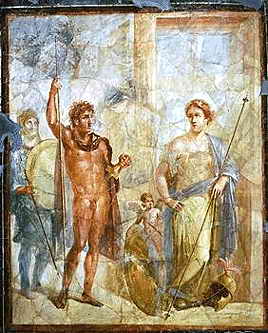Top Qs
Timeline
Chat
Perspective
Transcontinental royal intermarriage
Practice of ruling dynasties of different continents marrying into each other From Wikipedia, the free encyclopedia
Remove ads
Transcontinental royal intermarriages is royal intermarriage between royal families originating from different continents. One of the best-known instances of transcontinental royal intermarriage is the one between Alexander the Great, king of Macedon, and his three Persian wives, Roxana, Stateira and Parysatis.

Remove ads
Ancient Macedonia
Alexander the Great and the Susa weddings
in 327 BC, during his conquest of the Achaemenid Empire, Alexander the Great fell in love with Roxana, daughter of the Bactrian nobleman Oxyartes, and married her despite his companions' opposition. Roxana will later give birth to a son after Alexander's death, Alexander IV of Macedon.[1][2]
After Alexander defeated Darius III at the Battle of Issus, he captured his family, including his daughter Stateira. In 324 BC, during a mass wedding known as the Susa weddings, Alexander married both Stateira and her cousin Parysatis, members of the Achaemenid dynasty. Other notable marriages that occurred during the Susa weddings are the one between Selecus I and the Sogdian noble Apama and the one between Ptolemy I and the Persian noble Artakama[3][4][5]
Remove ads
Byzantine Empire
Summarize
Perspective
Khazarian dynasties
In 695, the Byzantine emperor Justinian II was deposed and exiled to Crimea. In 703, he escaped and received help by Busir, khagan of Khazaria, who offered him his sister's hand. Justinian accepted and renamed her Theodora, probably after the wife of Justinian I. The couple had one son, co-emperor Tiberius IV.[6][7][8]
Around 732, to solidify an alliance with Khazaria, the future emperor Constantine V married Tzitzak, daughter of khagan Bihar. Tzitzak was later renamed "Irene". The marriage produced Byzantine emperor Leo IV, who was given the epithet "the Khazar" referencing his maternal descent.[7][9]
Armenia and Georgia

Due to the closeness of the empire with the two realms, Byzantine royals often married with Armenian and Georgian dynasties. Here follows a list of documented marriages:
- Emperor Michael VII and Maria of Alania.[10]
- Emperor Nikephoros III and Maria of Alania.[10]
- Hovhannes-Smbat III of Armenia and an Argyra (niece of emperor Romanos III)[citation needed]
- Constantine I of Armenia and Pokhaina (relative of emperor Nikephoros II Phokas)[11]
- Theodore I of Nicaea and Philippa of Armenia.[12]
- David VI of Georgia and Theodora Doukaina Palaeologina (daughter of emperor Michael VIII).[13]
- Emperor Michael IX and Rita of Armenia.[14]
- Demetrius II of Georgia and Megale Komnena (daughter of Manuel I of Trebizond).[citation needed]
- Bagrat V of Georgia and Helene of Trebizond.[15]
- Bagrat V of Georgia and Anna of Trebizond.[15]
Mongol khanates
Around 1265, Byzantine Emperor Michael VIII attempted to start diplomatic relationships with the Mongol Ilkhanate. A marriage was combined between Ilkhan Hulagu, and Michael's illegitimate daughter, Maria Palaiologina. Maria left Costantinople in 1265, but when she arrived in Caesarea she was informed that Hulagu had died, so it was decided for her to marry Hulagu's son, Abaqa. The Mongols called Maria "Despina Khatun". The marriage produced a daughter, Theodora Ara Qutlugh.[16][17][18][19]
Michael VIII also tried to form an alliance with the Golden Horde. In 1266, he gave another illegitimate daughter, Euphrosyne Palaiologina, in marriage to the khan Nogai. There are no known children resulting from this marriage.[20]
Remove ads
England
Failed alliance with the Ayyubids
In a negotiation between Richard the Lionheart and Saladin during the third crusade, it was proposed to arrange a marriage between al-Adil, Saladin's brother, and either Richard's sister Joan or his niece Eleanor. The arrangement however failed for religious reasons.[21]
Hungary
Cumania
Around 1238, Béla IV of Hungary arranged a marriage between his son, future Stephen V, and Elizabeth, the daughter of a Cuman leader whom he had invited to settle in the plains along the river Tisza. This leader is either khan Köten or a man named Seyhan. The marriage resulted in 4 daughters and 2 sons, among whom there is Laudislaus IV, who succeeded his father, and who was nicknamed "the Cuman" for his mother's origins.[22][23][24][25]
Remove ads
Russia
Mongol khanates
In 1315, Yury, prince of Moscow, sealed an alliance with khan Uzbeg of the Golden Horde by marrying his sister Konchaka. Konchaka then converted to orthodoxy and was renamed "Agafiia". She was imprisoned in a war to take the principality of Vladimir and died before she could give Yury any sons.[26][27]
Georgia
Europe
After the annexation of Georgia by the Russian Empire, the Georgians gradually entered into the Western cultural sphere. This came following centuries of staying within the Persian cultural sphere and multiple intermarriages with the Mongols, the Shirvanshahs, the Seljuks, and the Safavid and Afsharid dynasties of Persia. Although, the Bagrationi Dynasty lost its royal dignity and became subsumed into the Russian nobility, they were nonetheless still able to achieve several marriages with reigning or fellow previously-reigning royal houses from Europe. There are inconsistent and conflicting designations of such unions as dynastic or morganatic. Here is a short list of such marriages:
Remove ads
References
Wikiwand - on
Seamless Wikipedia browsing. On steroids.
Remove ads
